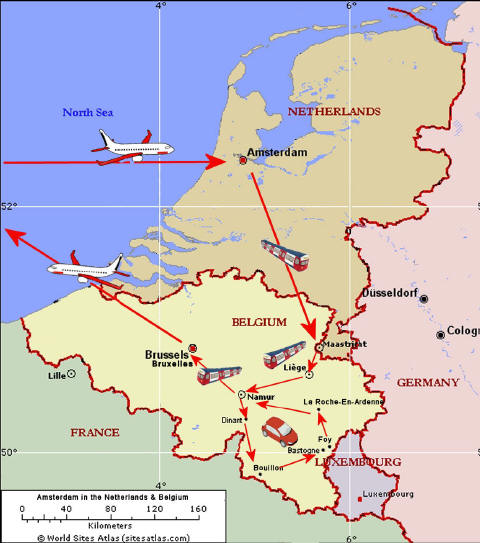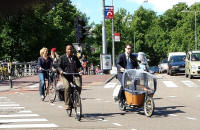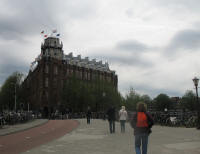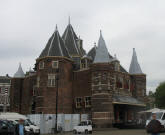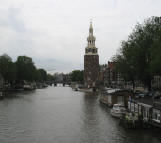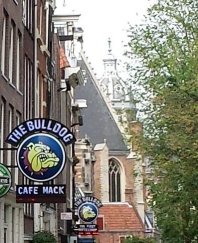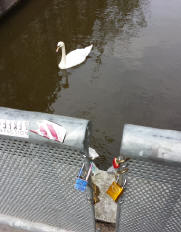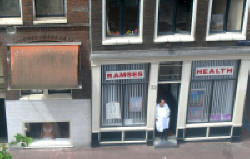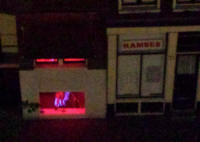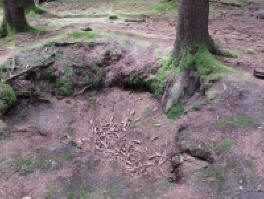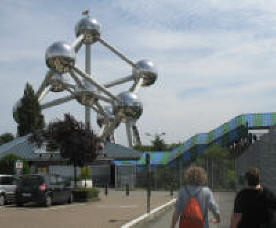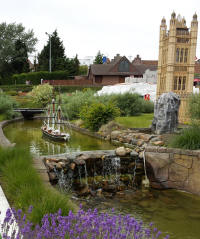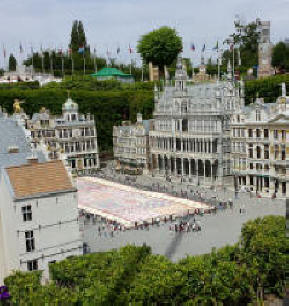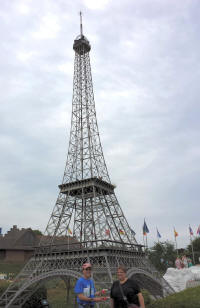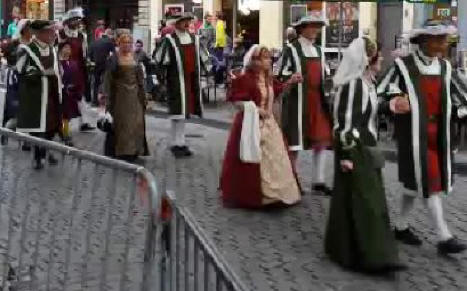 |
Amsterdam
&
Brussels |
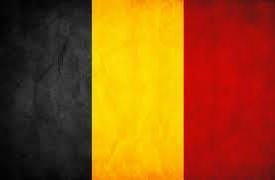 |
 _________________top__________________
_________________top__________________

Fly to Amsterdam
|
 |
|
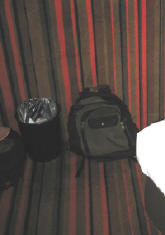 |
We flew from Roanoke to Philly and then on
to Amsterdam. A short train ride took us into the city.
On the left is the train station ... impressive!
Our hotel, the
WestCord City Centre, was just a short walk from the train
station and centrally located to the city.
The room itself is hilarious. The picture on the right shows
how they carpeted a section of the floor right up the wall and
to the ceiling.
|
|
 _________________top__________________
_________________top__________________

Amsterdam
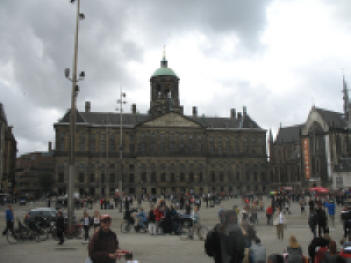 |
On our first day, we walked
around the city to get a feel for the layout and distances. We
saw Dam Square which was filled with people and pigeons and
the
GrandPalace that is now a museum (left).
We also went by the Anne Frank house. On the right is the line
to visit it - averages two to three hour wait. It is well
worth clicking on the picture for the larger size to see how
far back that line goes. (This one one we were going to skip.) |
 |
|
Rijkmuseum
This museum was on the edge of the city ring to the south.
We could have taken public transportation, but it was so much
fun to walk! |
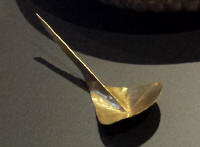 |
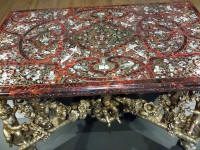 |
| |
gold
spoon - such a simple design |
mother
of pearl, precious gems, and tortoise shell inlayed table |
 |
 |
 |
|
another fabulous inlay |
olive
wood covered cabinet |
close-up of the olive wood grain |
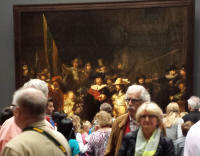 |
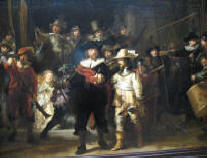 |
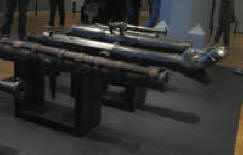 |
The Night Watch -
De Nachtwacht by
Rembrandt
It was painted in 1642 and measures 11.91 ft
× 14.34 ft. At this period of time, most military paintings
were stiff and lacked depth. This was one of the first times
light and shadows, motion, and depth were used. |
great
cannons |
|
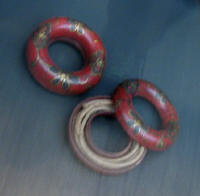 |
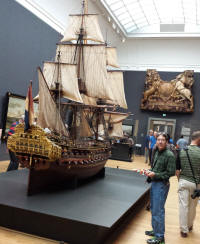 |
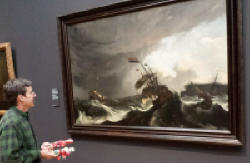 |
|
matchlock fuses in carrying cases |
scale
model with all the details |
one of
the most beautifully painted paintings |
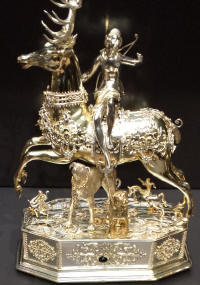 |
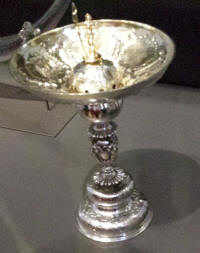 |
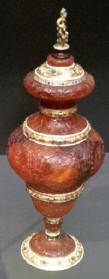 |
Diana
on a Stag - c. 1613-1615
"This is an expensive toy for entertainment of dinner guests.
It can roll over the table, since the base of the 'sculpture'
has wheels and a movement to propel it forward. The head of
the stag can be removed and its body filled with wine. The
guest in front of whom Diana stops may take the first drink."
(from museum tag) |
Henjel in the Kelder - Hansel in the Cellar
When a woman found out that she was pregnant, she was not
suppose to tell anyone verbally (evil spirits may hear her).
Instead, she would use a goblet like this. When filled with
liquid, a trap door would open revealing a figure of a baby.
Everyone would pass the goblet around and take a
congratulatory drink.
|
Amber
with gold and precious gems. When the lid is removed, light
come through the top to light up the carved medallions. |
|
 |
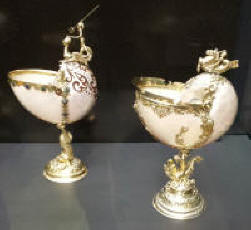 |
 |
Three of these goblets are made with nautilus seashells and
one from a turban shell.
The two on the right are close-ups. The are encrusted with
gold filigree and gems.
The ostridge is said to represent virtue as it is the fastest
two-legged animal running,
and therefore, virtue always triumphs. c. 1550
|
This
picture and the three below are of rock crystal (quartz)
carvings - goblets, pitchers, bowls, etc. The craftsmanship is
incredible.
c. mid 1600 |
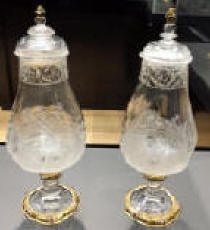 |
 |

Quartz was thought to crack or turn color if exposed to any
poisons; consequently, it was extensively used by the rich and
powerful. |
|
|
|
 _________________top__________________
_________________top__________________

Outside the
Rijimuseum was a lovely little park with a very cool water
feature. Curtains of water would rise and fall on the four
sides allowing people to step in have their photo taken and
then wait for another wall to recede and step out.
Looked like fun! Bob said he would take the pictures, if Amy
would go in. "Sure!"
She heard "Go! Go!" Bob says he said "No!
No!"
Two walls of water later, then trapped on the inside forever,
dripping and soaked, Amy was the delight of the crowd.
Thank the-powers-that-be that Bob always carries a paper
towel/napkin with him. After Amy took the water out of her
shoes, wringed out the bottom of her shirt, she could finally
dry her face and glasses. (Yea, I won't live this one down any
time soon.) :) |
 |
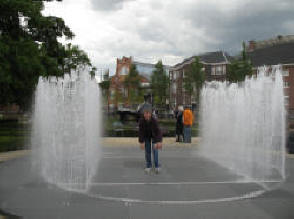 |
 |
|
|
|
 _________________top__________________
_________________top__________________

On to the
Heineken Beer Experience - and an experience it was!
|
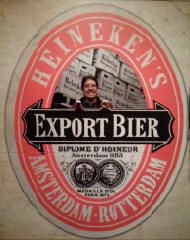 |
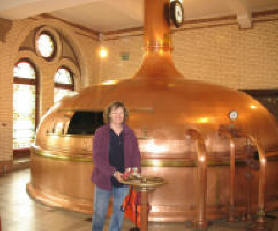 |
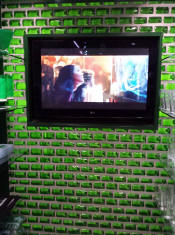 |
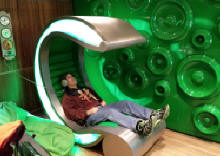 |
We
would definitely recommend this to everyone!
The vats, wort tasting (the stuff that is beer before it
ferments), the horses and stables that pull the cart every
morning through town, interactive displays, engrave your own
beer bottle, make a sing along video, and get your
certificate, "become a beer ride" (shakes, rolls, heat,
bubbles, and so much more fun), and, our personal favorite,
the carpet of digital images that scoot away from your feet as
you walk down the corridor!
At one time, Heineken even designed beer bottles that that fit
into each other to build walls. We took the Heineken beer boat
ride back to the main part of the city.
Just a really good time! |
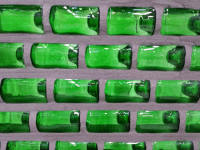 |
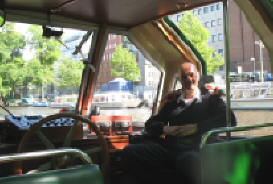 |
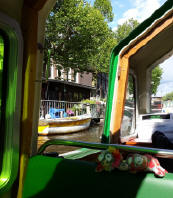 |
 _________________top__________________
_________________top__________________

|
 |
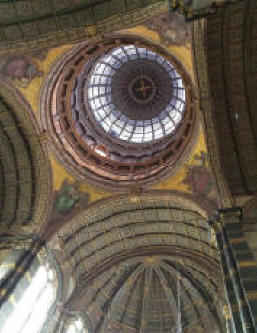 |
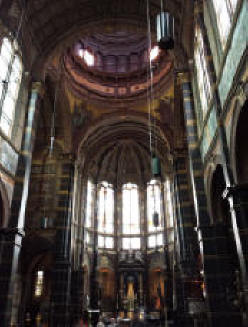 |
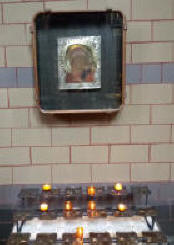 |
Sint Nicolaaskerk
Sint Nicolasskerk was built between 1884 and 1887. It is
located close to the train station. The dome is 190 feet tall
and fantastic. As always, we lit a small candle for out loved
ones. |
|
|
|
 _________________top__________________
_________________top__________________

The Church in the Attic - Lieve Heer op Solder
During the 17th century the Christians and Protestants were
vying for control of religion of the land. When the
Protestants secured control, all Christian masses had to be
held in private (out of public view). They were still banned
and "illegal", but were tolerated as long as they were not
seen. This house was modified in 1663 to house a Christian
church in its attic. 200 or more people a week would come
through the doors to worship and celebrate mass in their faith
or choice. It is a "common house" from the outside - so much
so that it was hard to find walking down the street. It was
well work the time. the beds, as typical in the day, were
small - rather like a cupboard with a mattress. The views from
the windows showed how houses in the area were showing their
age and the spire of the Christian church as later
restrictions were abolished and new churches built. There were
two levels that looked over the main alter. And, unbelievably,
what looked like marble columns were actually very well
hand-painted plaster or stone. |

|
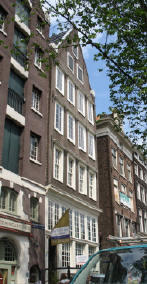
|

|
 |
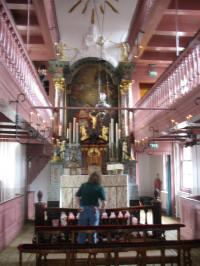 |
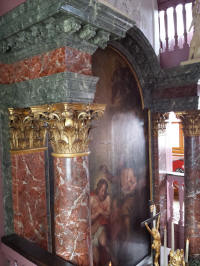 |
|
|
|
 |
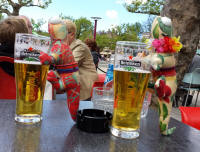 |
We went on to walk
around Amsterdam and came up on the I amsterdam
logo that is used by the
tourist department. You can climb on it, stand under it,
or just admire it. Bob and K&K are between the letters a & m.
And then, of course, K&K needed a beer in the plaza next
door. |
|
|
|
 _________________top__________________
_________________top__________________

Old Church - Oude Kerk
A gothic style church founded in the 13th century
(several enlargements took place between 1330 and 1571) and
dedicated to the patron saint of seafarers, Saint Nicolas. In front
of the church is the oldest city garden dated to 1260.
|
The paintings on the roof
(wooden interior sections) were partially restored to show the
detail of the images.
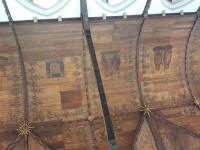 |
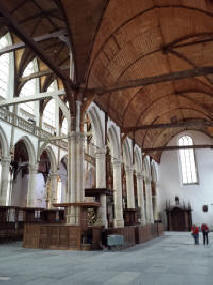 |
The spiral staircase is unique -
the inside twist is a masterpiece forming the vertical line
within the staircase.
Below are the organ pipes.
It took almost the full length of the church to get them in
frame.
They are huge!
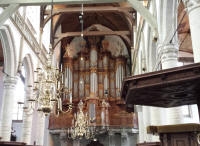 |
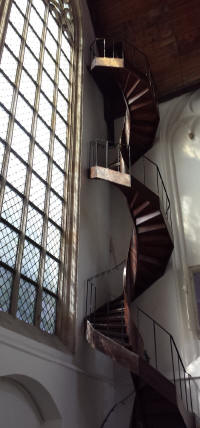 |
|
Between 1250 and 1865, 2,500 tombstones
were set in place on the floor of the church. Representing 35
generations, there are 10,000 people buried beneath the
flooring.
The graves of Saskla (Rembrandt's wife),
Frans Banning Cocq (the central figure in Rembrandt's painting
The Night Watch), and Masyken (wife of poet Vondel).
To see a full map
http://www.oudekerk.nl/en/
and grave-on-line link. |
|
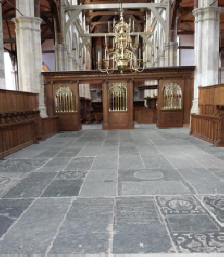 |
 |
 |
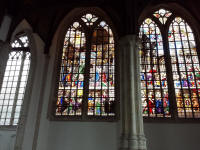
The stained glass is from the 16th and 17th centuries. |
 _________________top__________________
_________________top__________________

 _________________top__________________
_________________top__________________

Our hotel was on the edge of the red-light district. Oude Kerk
was in the middle. Amsterdam was one of the most safe feeling cities
we had been in. With that said, we did not venture out after dark
... of course, "dark" was after 10:00 pm. The fist two pictures are
out our hotel window - day then night. The next is a condom shop.
The fourth and final is of one of the canals with a big bad live
theater of ... well ... red-light acts.
|

| Train Day to Namur
We woke up early to check out and walk the few blocks to the
train station.
It was a day of "Fortunately" and "Unfortunately" ...
Fortunately, we bought online open ride tickets in advance - if
you can get from A to B, no matter what train or day, you get to
ride.
Unfortunately, as in all Europe, train schedules change daily or
hourly - without any notice.
Fortunately, we got to the train station an hour early.
Unfortunately, there were no trains going where we were going that
day (major schedule change due to rail work).
Fortunately, we immediately asked what was going on at the info
desk (and she spoke enough English to help us).
Unfortunately, it was now not a three train change, but a six
train change - and we had ten minutes to get to the first one way
down the station.
Fortunately, it looked like we would get to Namur only 30 minutes
later - 5:00ish.
Unfortunately, one of the trains was cancelled but the next would be
in in time for our transfer, that left us with a two minute window
to sprint across the tracks to get the fourth connection.
Fortunately, we made it.
We checked into
Hotel Ibis Namur Centre in the late afternoon, dropped our bags,
and took a small walk around to orient ourselves.
|
 _________________top__________________
_________________top__________________

| Get Car & See Namur
In the morning we checked out, walked a few blocks to the car
rental agency, and ended up with a brand new VW Polo - bright red!
:)
The people were so great - we ended up getting the full insurance
for a cost - but the ramifications of anything happening and the
ease of handling it were well worth it. (Of course, nothing did
happen, but the comfort level was worth every dollar.)
The best part was that it was a stick shift. It took Bob a little
time to get use to driving one again - but he was GREAT! The
employees even got out in the road to stop traffic as we pulled out
(a difficult blind curve even if driving in the U.S.)! We, of course
stalled in the middle of the intersection which made them nervous,
but Bob recovered nicely. :)
We had bought a GPS card for the area and had programmed in our
major points at home in the U.S. It worked great ... after it realized we
weren't in the U.S. any more. It took a long time to find the
new satellites, we had to tell it to use kilometers per hour,
and get it to keep speaking English - but other than that, we
could not have survived without it and the trip planning we
did at home.
|
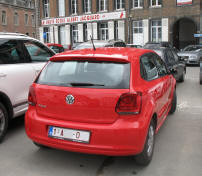
our little red car |
We were impressed by the e-bikes. One can
look up where the bike are, how many are there, and can even
pay for them in advance. Pick them up, ride them, plug them in
for more juice around the city, and finally, drop them off at
the same or different station! That ROCKS!
(No we did not use them - feet also
rock!) |
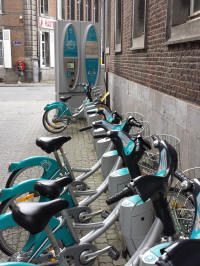 |
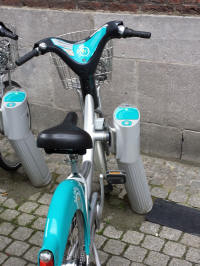 |
|
 _________________top__________________
_________________top__________________

The Church of Saint-Loup - L'Eglise Saint-Loup
|
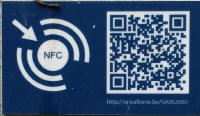
 |
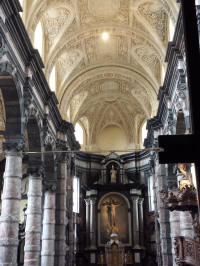 |
Three stories high
and baroque in design, this was one of the most incredible
churches we saw. (And, yes, it also had a QR code) It was
built between 1621 and 1645. The ceilings are carved freestone
- white to ivory in color to contrast with the raw stone
pillars.
The beautifully carved oak confessionals line one side of
the church.
|
|
|
|
|
 _________________top__________________
_________________top__________________

The Namur Citadel
The citadel covers 198 acres and is therefore one of
the largest in Europe. It is built on Champean hill where the rivers
Sambre and Meuse come together. It was built in three sections over
the centuries. From the 10th to the 15th century, the Citadel was
actually "The Castle of the Counts". It was a smaller set of
buildings at the tip of the cliff where the earls of Namur lived. In
the 13th century, it started to become a fortress with larger walls,
towers to protect the earls, and a cannon house.
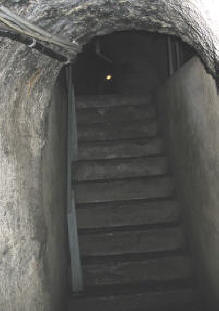 |
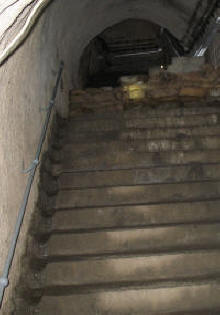 |
During the 16th century (called the "mediane"),
the area was increasing in importance and wealth. Namur was
situated at the crossroads of heavily traveled routes. Cannons
were being used more often and made the buildings vulnerable,
so stronger fortifications were built.
It was during this period that the fortress
became a citadel with earth packs roofs to absorb the cannon
ball shock. |


|
 |
During the 17th century,
Terra-Nova was added at the
upper end of the citadel. New defensive underground passages
and galleries were created.
The large building at the top is the
barracks.
The steps were interesting as they were
designed to serve other functions as well. The left steps were
built with a high rise and short foot surface. This made them
easy to climb, but hard to descend. Other stairs had a slight
curve in the middle and gutters on the edges to collect rain
water for the men. |
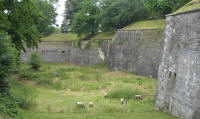 
|
 |
 _________________top__________________
_________________top__________________

|
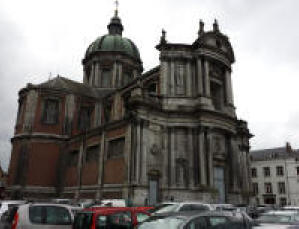 |
Saint Aubin's Cathedral
See a 360O controllable video
of the inside Saint Aubin's Cathedral was
build on top of an older church that dated back to 1047. As
the church was built and rebuilt through the centuries, the
present cathedral was completed between 1751 to 1767.
The interior of the dome is 229 feet tall
and the cathedral measures 256 feet long. It is beautiful.
We drove to Dinant in the late afternoon. |
 |
|
 _________________top__________________
_________________top__________________

Dinant
We were delighted to find that
Hotel Ibis Dinant was within walking distance to the Citadel - we were
a bit worried when we booked it. As you enter the town, you pass Albert's
Rock. They say young King Albert I used to climb it for fun.
Driving into Dinant was an experience.... After stopping
to take the picture of the towering rocks the road ran straight through,
our GPS decided that it didn't like us any more. It may have lost contact
with the satellites, but it was bound and determined to get us lost in a
town with only a few streets that were practically all one way. We never
want to hear the word "recalculating" again. :)
Finally we
found small signs that showed us the way. .
|
 |
 |
The Citadel & Notre Dame of Dinant from ground level were
inspiring!
Below: inside Notre Dame of Dinant -
* Saint Perpète is the patron saint of Dinant. He died November 4,
614. This gold guilt bust was made in 1621.
* Stained glass from the 15th century
* In 1227, falling rocks from the cliff destroyed the original
church. This one was built on the foundations of the old one. We
were amazed to see brick work between the arches of the ceiling.
The cliff is 328 feet above the river Muese. The first
fortress was built around 1040. The town and castle were destroyed
in 1466. In 1523, the castle was rebuilt and the 408 step stairway
was added going up to one of the side walls. From 1818 to 1821, it
was destroyed again. This final rebuild it the one we see today.
|
|
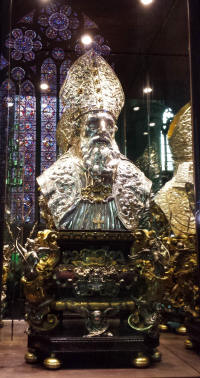 |
 |
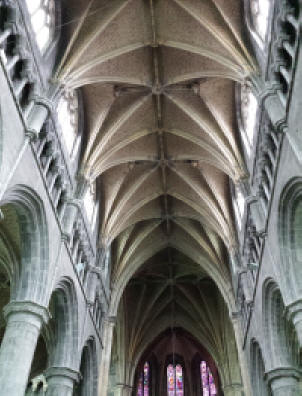
|
|
|
 |
While inside the Cathedral, we lit a candle
focusing on Ruth's son Michael.
Below is a "seamed together picture" from two we took of the Citadel
&
Notre Dame of Dinant. Our camera just couldn't take in the entire
vista.
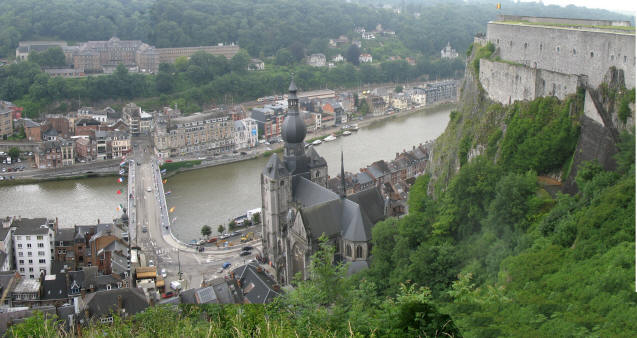 |
|
"In 1466 the area
was divided into 17 different providences. The Dukes of Burgundy
united these areas with the exception of Liege (and therefore
Dinant). "Charles the Bold looted and ransacked Dinant and ordered
800 residents to be tied together, two by two, and thrown into the
Meuse from the bridge above."
From the sign at site |
 |
 |
|
The two images
prior to seaming
them together
|
|
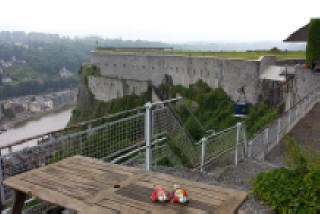 |
 |
 |
|
K&K at the top of the Citadel
with the tram that you ride to the
top in the background. |
Looking back down the river
with the new highway bridge
in the background. |
The Meuse River divided two providences/states -
Dinant (Dutch) on the fortress side from Leige (German) on the other
side. For centuries, they were, at best, antagonistic, at worst,
warring. Today they are united and flourishing. |
|
 |
On the left:
"These piles supported the first bridge of Dinant, built by the
Wauksort Monks in the 11th century. They were taken out of the Meuse
in 1952 when
the current bridge was being built. They thus remained in the water
for approximately 900 years."
From sign at siteOn the right:
The bridge as it stands now.
|
 |
|
A shell hit one of the underground bunkers that had
been added onto the citadel in more recent times. When it detonated,
it shifted the entire concrete bunker to a 30 degree angle. Although
in later years the walls became unstable, it has been recreated to
demonstrate the bizarre surroundings.
And yes, to stand straight up while looking at
others tilting on an angle was dizzying! |

|
Dinant is the birthplace of Adolphe Sax, the
inventor of the saxophone.
The bridge is lined with huge saxophones decorated
by different countries.
Fun! |
 |
 _________________top__________________
_________________top__________________

Château Bouillon
In feudal times (1100's to 1500's), the kings owned all the land. He
would divide up parcels to give to nobles who, in return, would help him
protect his lands. The nobles gave some to people lower than themselves
for the same reason, and those people gave it to serfs to help them farm
the land. A bit of everything was given back to the king. A great resource
to learn more is located
here.
The Château Fort's history is first mentioned in writing in 988, and
although now written records survive is is thought to have existed for
centuries before that. In 1096, Godfrey (the Duke at the time), sold all
his lands and the fortress in order to go on the first Crusade. He
conquered Jerusalem (later dying there) with the title of "Defender of the
Holy Sepulcher" when he refused to wear the gold crown of a king since
Jesus, the King of kings, wore only a crown of thorns.
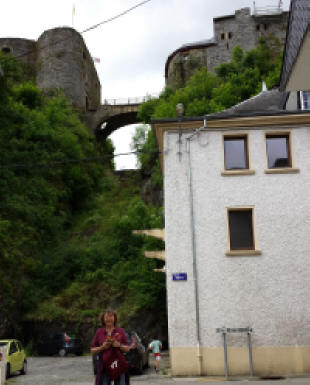
|
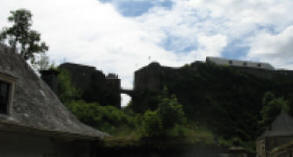
There were originally three wooden bridges which were covered in
stone by 1716.
The innermost spanned a mote carved out of the natural rock and
could be filled with water from inside. |
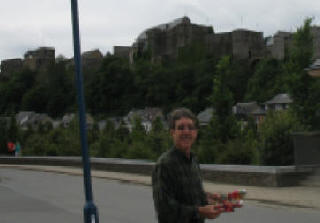
|
|
A feudal Château (or castle) was built to protect the people and
lords. To be a feudal castle, there must be successive layers and
heights of walls and fortified positions. Each of the upper areas
protect the lower areas. They are built/shaped by the rock and land
they sit on and by their ability to see and fire upon any threats.
At the highest point the Tower stands 245 feet above the town.
|
|
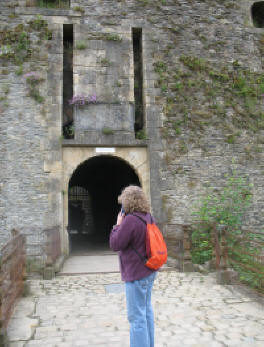 |
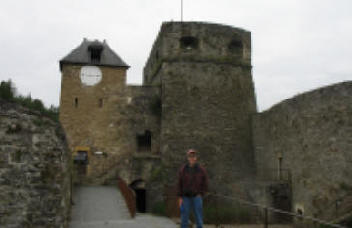 |
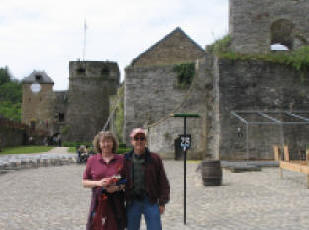 |
|
On the left, Amy is listening to an audio tour.
Within the courtyard is the powder house where the gunpowder was
stored and covered in a layer of charcoal to absorb moisture and
keep it dry.
Water is a important component of any fortress.
This one had a man-made well that was dug through pure rock to the
level of the Semois river - 201 feet down and seven feet in
diameter! It also had a cistern with an area of more then 1,000
feet. A natural spring would keep the cistern filled to a constant
level - even in time of drought. |
|
 |
 |
 |
|
These are unusual double-storied, three slotted
loop-holes used to fire weapons through. They have a Y design
allowing six directions of shots to be made. The walls were three
feet thick.
|
Within the underground passages and fortifications
are air-ducts that double as
speaking tubes. Soldiers could relay
orders through these tubes from the basement,
middle area, or
surface
strong-holds. |
|
 |
On right:
Looking down over the courtyard (with the bleachers for the falconry
show).
Far right:
The area below the Château Fort has been called "Bishop's Field"
since 1141. Evidently, in 1134 in a surprise attack, Raymond de Bar
captured the Château from the Prince-Bishop of |
 |
 |
|
This wheel was attached to a
crank shaft and ropes. Men
would get inside and walk to
bring water up from the well.
It is seven feet in diameter. |
Leige. The Prince-Bishop wanted it back and laid
siege to it with his army. Nothing was working and his men were
starting to give up hope. So, he brought the holy
shrine of St. Lambert (which contained his body) from the far, far
away town of Leige to the battle field. It inspired his men and
terrified the army occupying the Château . They simply surrendered,
thinking that they could not fight against Heaven. |
 _________________top__________________
_________________top__________________

The Falconry Show
The show was fantastic! - and one of the reasons we decided on this
fortress. All the birds were tethered to their little A-frame shelters
with shade and water available. They were outside during the day and
behind the hedge so visitors could see them, but not get to close. The
second pictures shows three owls - the little shelter in the middle had a
tiny owl in it. (See the third picture - a blow-up of the second.) The
last picture is of a really big falcon. He was sounding off during the
entire show.
|
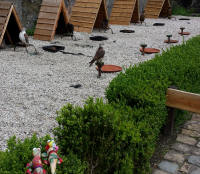 |
 |
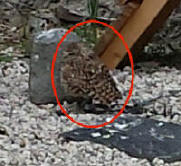 |
 |
|
Of course, the entire thing was in French, so we
didn't learn a lot. :) But the birds would fly directly over
our heads and land on walls all around us. |
|

|
 |
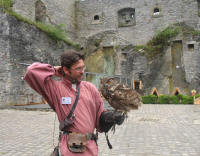
|
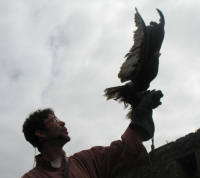 |
|
|
|
|
|
 |
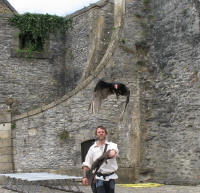
|
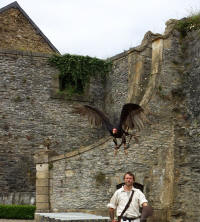
|
One of the birds was a vulture. He tended to keep
his wings spread out when sitting still. Must be some survival
thing, but we have not investigated it yet. |
|
|
|
|
|
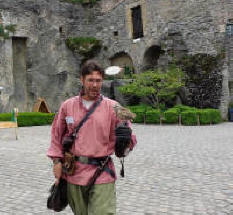 |
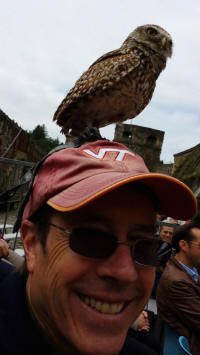
|
We loved the little baby owl. When they set him
down on the ground he would wobble around with the tethers on his
feet.
Quite funny!
And then the gentleman came over and set him on
Bob's hat.
Great shot! |
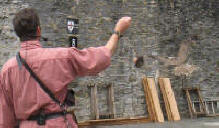
The man is swinging a small sausage on a string
around in circles. The falcon is coming in to try to catch it. This
is the way they train the birds for hunting. (And yes, the falcon
snagged the sausage out of the air on his third try. Impressive to
watch.) |
|
 |
After the show we could go up and have our picture
taken with the little owl and the true hunting falcon (you can see
his mask is back on). |
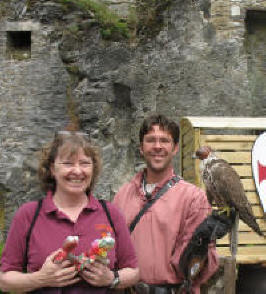 |
 _________________top__________________
_________________top__________________

Foy / Bastogne
This is where the Battle of the Bulge occurred - the deadliest conflict
in the U.S. Army's history. Just off a small road between Foy (pronounced
Fwa) and Bastogne, and a few feet into the trees, are the remains of the
foxholes our soldiers used for defense.
It is an eerily quite place where you can feel the history down to your
bones. Located at 50O 1.929 N 5O 45.195 E
|
 |
American
Airborne
MemorialDown the road its a small monument to
the
1001st Airborne Division -
The Screaming Eagles.
The memorial just sits quietly and stoically on
the side of the road. The signs to get to it are
small if even posted. It isn't a tourist attraction,
it is a solemn reminder and message of thanks from the people of
Belgium.
Located at
50O 1.721 N
5O 45.404 E |
 |
|
 |
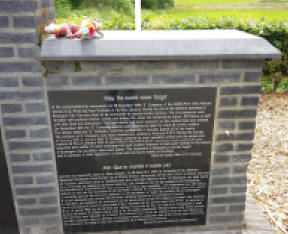 |
 _________________top__________________
_________________top__________________

| Bois de la Paix - The Trees of Peace
(or Woods of Peace) "The 4,000 trees were planted in the year
of the 50th anniversary of the Battle of the Bulge. They are
dedicated to the American veterans who fought in the Ardennes, to
the Belgian soldiers as well as to all civilian and military
casualties of the winter of 1944-1945."
"What is also remarkable about the Peace Woods is that they are
laid out to form the UNICEF emblem: a mother and her child,
the symbol of human tenderness. This picture can only be seen from
the sky, so that those who passed away will know that they did not
die in vain."
From the sign on site / sky view captured from Google
Earth
Each solder can have choose a tree and have his or her name
plaque in front of it.
Located at 50O 1.730 N 5O
46.149 E |
|
 |
 |
 |
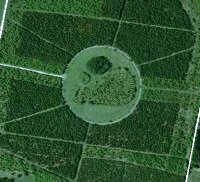 |
 _________________top__________________
_________________top__________________

Mardasson Memorial
The Mardasson Memorial "honours the memory of the 76,890
American soldiers who were wounded or killed during the Battle of the
Bulge.
While first steps towards the memorial were undertaken on July 4, 1946, by
presenting some earth from the site to U.S. President Harry Truman, the
monument was dedicated on July 16, 1950. Architect Georges Dedoyard
designed the complex as a pentagram with a height of 12 metres (39 ft) and
a side length of 31 metres (102 ft), centered by a circular atrium with a
diameter of 20 metres (66 ft). While the inner walls are covered with ten
paintings from the battle, the outer crown is engraved with the names of
the contemporary 48 U.S. States, and the insignia of most participating
battalions are shown on the walls. Below the structure, a crypt with three
altars – one each for Protestant, Catholic and Jewish services – was
carved, and decorated with mosaics by French artist Fernand Léger.
The Latin inscription on the memorial stone:
LIBERATORIBVS AMERICANIS POPVLVS BELGICVS MEMOR
IV.VII.MCMXLVI.
translates to "The Belgian people remember their American liberators – 4th
July 1946.""
From Wikipedia
|
 |
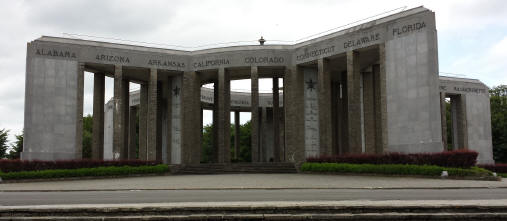 |
 |
| 101st Screaming Eagle Memorial |
Bob on top with K&K |
K&K peeking out of the barrel |
| |
|
|
|

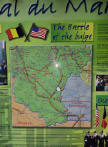
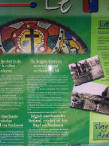
|
|
The sign at the site
(to large as one photo
to be readable) |
We drove from Bastogne to La Roche (about 30 minutes) and checked into
Hotel Du Midi.
After a wondering around the town for a bit and a
getting truly icky hamburger for dinner, we settled in and got a good
night's sleep.
 _________________top__________________
_________________top__________________

Le Château Féodal de La Roche-en-Ardenne
Morning of July 1st on our 30th
Anniversary
The Weather Gods were on our side again. It only rains at night in
Belgium. :) We only had a few hours to tour the ruins and then
we had to drive to Namur, turn in the car, and catch our train to
Brussels. We checked out early and headed off to the Citadel.
History: Although in 1903 excavations revealed flint, stoneware,
and pottery from the prehistoric era; in 1954, a Roman coin was found
dating to 307-337 BC. After the Romans had conquered Gaul and the Ardennes
in 53 BC, they built a fort here. As the centuries pasted, the fort was
turned into a fortress and by the 9th century it could be termed a
medieval castle/fortress. By the 12th century, it became important to the
protect the English wool trade routes and the ships on the river.
The castle was inhabited until 1780. After it was abandoned, the locals
used mush of the stone for building materials in the town. Until the late
1990's, the courtyards and most of the underground were buried in hundreds
and hundreds of feet of dirt. In the summer a festival is held for a few
months showcasing the ghost of the castle.
"In World War II, the town suffered severe damage. Having been liberated
by the Allies in September 1944, the town was recaptured by the Germans in
December, during the Battle of the Bulge. The subsequent Allied bombing
raids resulted in the town being liberated once more in January 1945, but
left much of the town destroyed."
http://en.wikipedia.org/wiki/La_Roche-en-Ardenne
 |
 |
|
The town and castle sit beside the river Ourthe
and the castle was built on Deister hill. |
One can see how impressive this would have been
when intact.
(It is still impressive!) |

There is no way to drive or ride to the top. You have to find this
narrow little alley and walk the cobble stone path to the top. |
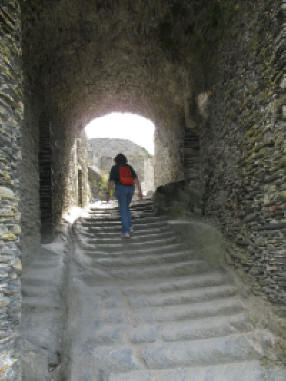 |

The stairs within the castle were chiseled out of the solid
rock foundation. Time had worn them down, but in the large picture
you can see all the striations.
The walls towered over us as we climbed. |
|
|
|

As with any castle/fortress of this time,
the land had a great impact on building
the actual structures. |
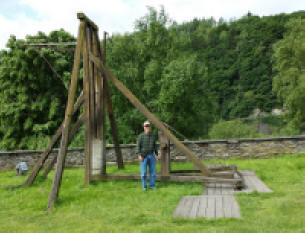
We found a fascinating machine of war. Built like a
traditional catapult, this one shot metal tipped javelins that were
5 to 6 feet in length. |

K&K look down over the tiered walls
toward the town. |
|
The javelin was placed in a cradle at the top front.
The lower, center portion was made of a solid vertical support with
green posts lashed to the bottom. The green (and therefore
malleable) wood was cranked back and locked in place. A release
mechanism freed the green wood which would return to the upright
position, slamming into the end of the javelin rocketing it into the
troops below. It might not have killed a lot of people, but it would
certainly, according to Bob, "make them think about taking that next
step forward." |
|
|
|
The entire
Château Fort of La Roche was built out of
interlocking local stone - some times digging into it, sometimes
seaming up to it, but often using gravity and a sand and chalk
mortar to gain height, thickness of the walls, and doorways.
 |
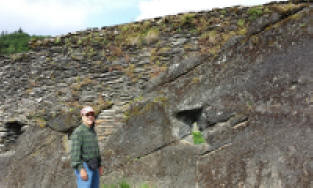
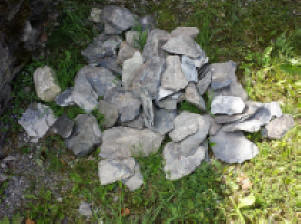 |
The Three S's: Shale, Slate, and SchistThese three rocks have
basic differences in composition that make huge differences in
hardness, stability, and ease of working.
All three tend to break or cleave along flat, parallel lines,
giving them a flattened look.
Shale is a sedimentary rock made of a mix of flakes clay
and fragments of mud. It is the most abundant rock on earth.
Slate is a metamorphic rock. It is grained with tiny mica
flecks. It also has excellent, linear cleavage.
Schist is also a metamorphic rock. It has medium to large
flakes of mica and cleaves in roughly parallel lines. (It tends to
be more sparkly in the sunlight.)
We are not sure which material or materials were actually used.
One website says that the stone was shale. All three would have been
readily available and were probably used in different locations for
different purposes. |

To Namur & Train to Brussels
|
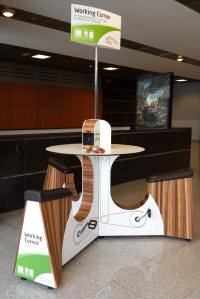 |
|
From La Roche to Namur was only an hour drive -
and through wonderful country side and empty roads.
As we arrived, we thanked the GPS again. Cities
are very difficult to navigate, round-abouts and one way streets
abounded.
Gas is also VERY expensive. The signs are so
intimidating, until you realize that they sell in liters. We figured
that the price was just over $6.00 per gallon. Maybe why the roads
we so empty?
Once we turned in the car, we walked the few
blocks to the train station where we saw this contraption.
It is a peddle powered mobile device charger.
The train ride was about an hour and very
relaxing. |
 _________________top__________________
_________________top__________________

Brussels - Bruxelles
Evening of July 1st on our 30th
Anniversary
When we got of the train at Brussels Midi station, we found that we
were just a few steps from our hotel (the
Ibis Brussels off Grand'Place)
in the center of the Grote Markt square! We checked in (Amy was
again impressed with the QR codes that were in the lobby) and took a
walk-about to
get orientated.
 |
 |
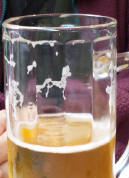 |
It was soon apparent that the word "Brussels" and the country of
Belgium was synonymous with waffles, chocolate, beer, and lace. We
indulged in each.
Bob even managed to leave the image of a horse in foam on the
edge of his glass which reminded us of the Heineken brewery in
Amsterdam. :) |
|
|
|
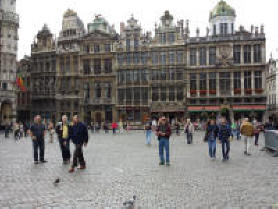 |
 |
The Grand Market or
Grote Markt is the central square in
Brussels. It is surrounded by guildhalls, the city's Town Hall, and
the Breadhouse (French: Maison du Roi, Dutch: Broodhuis). By the end
of the 11th century, the open air markets were being transformed
into guild-houses where apprentices were trained to the highest
standards. Individual and glorious buildings house the buckers,
bread makers, beer trades, and textile workers, to name a few.
In part from
http://en.wikipedia.org/wiki/Grand_Place |
 |

close-up |
In 1695, the French bombarded the city center with cannons and
mortars. It was defenseless and ultimately basically flattened. The
Grand Palace was destroyed and most of the city burned.
During the next four years, the city was rebuilt by the guild
houses. By the late 1700's the Grand Place was sacked again
destroying statues and facades of the guild houses and surrounding
buildings.
During the 19th century restoration and rebuilding was a priority
fixing and repairing the structures and their carved beauty.
Also in part from
http://en.wikipedia.org/wiki/Grand_Place |
| The Grand Place was
built in stages between 1401 and 1455. It is 315 feet high and has a
12 foot statue of St. Michael slaying a dragon on its top.
Trying to match or exceed this symbol of power, the Duke of
Brabant built his own grand building in 1504 to 1536. It was built
on the foundations of the first cloth and bread markets and became
known as the King's House (Maison du Roi in French and Broodhuis or
Breadhouse in Dutch), although no kings ever lived there.
Also in part from
http://en.wikipedia.org/wiki/Grand_Place |
 |
 |
|
Brussels abounds with marvelous statuary and small fountains
found around the city. The fountains gave access to water for the
citizens in olden times and current times. |
|
 _________________top__________________
_________________top__________________

|
|
Mannekin-Pis
Mannekin-Pis is regarded as a
symbol of the rebellious sprit of the city. It dates back to the 15th century.
Again, another QR code!
The other photos Show Amy & her family on visits
over the years. Note the differences in the shop window in the
upper right.
|
 |
 |
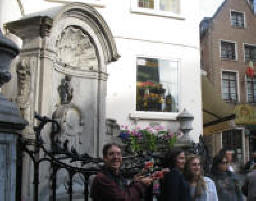 |
 |
 |
| 2013 - Bob and K&K |
1966 - Dad and We Three |
1991 - Mom |
 _____________________________________
_____________________________________

Anniversary Photos
All to soon it was time for dinner. We went back to the
hotel and asked what they would suggest for or 30th anniversary. The
waiter was delightful - he said straight up, "Nothing". He sent us down
the block a bit to
Chez Leon where Amy got a fabulous fillet (with little rounds of
garlic butter on top) and Bob got Moules Provencale (mussels topped with
tomatoes, cheese, and spices). Both meals ROCKED! On our way home we
bought a bottle of red wine - and toasted our lovely life together.
 |
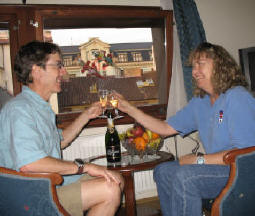 |
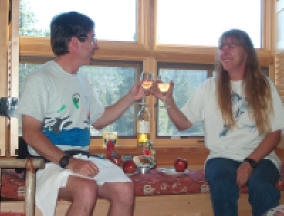 |
| 2013 - 30 years - Brussels, Belgium |
2010 - 27 years - Prague, Czech
Republic |
2003 - 20 years - Yellowstone,
Wyoming |
| |
|
|
 |
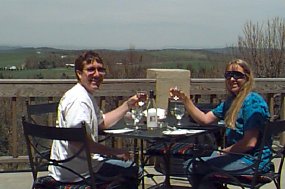 |
 |
| 2002 - 19 years - Switzerland |
1992 - 9 years - Château Morrisette,
Virginia |
1983 - Just married |
| |
|
|
 _________________top__________________
_________________top__________________

Meeting up with Jean and Jean-François
in Brussels!
|
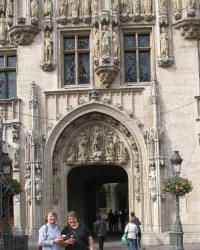 |
Jean is Amy's cousin on her dad's side. She and
Amy have met up in the most amazing places in the past. One time at
the bottom of the Grand Canyon!
It has been virtually forever since we have seen
each other or talked. When Bob and Amy and K&K emailed to say
they would be in her city for a few days this summer, she was all in
to show us around!
And it was delightful!!!! |
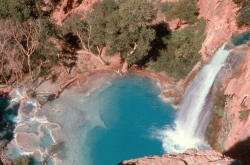
This is Havasu Falls in the Grand Canyon. Although we
can't find a picture of us together, it is a place Jean & Amy
crossed paths when young. |
| |
|
|
|
 |
 |
 |
 |
|
Jean took us back to Mannekan-Pis
(She told us that "pis" is not pronounced "pee" as in America,
but rather "piss" in French and Dutch.) Oh my ... I like it
our way.
And, for the first time ever, in all the Jager
family travels, we saw Himself dressed up! The tradition was started
towards the end of the 17th century. The weekend was to be hosting a
huge celebration of the solders of the city in ancient times. There
is actually a museum that houses his costumes - everything form
Ancients to Elvis to astronauts! (We did not have time to see it.)
There was a rumor that this festival would be one
of the ones where beer would flow from the fountain tonight. It does
happen from time to time on occasions such as this. We would have
loved to see it, but we had a long day ahead and an early flight out
in the morning.
Maybe next time. |
 _________________top__________________
_________________top__________________

|
The Cathedral of St. Michael and St. Gudula
Got to love a church/cathedral that has so many
names and Saints!
We spent a moment,
lost in time, with Jean ... lighting a candle for Amy's dad /Jean's uncle,
Alan Reynolds Jager. |
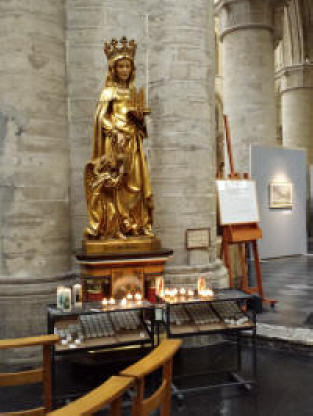
Oh how I miss you Dad. |
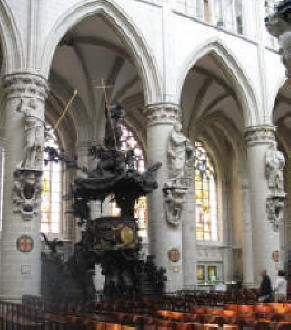
|
|
The Belgians have found ancient ruins dating
to the Roman times as they build and
rebuild the city.
Trying to preserve the past for the future, they have, at his site,
created a glass walled venues to the ruins below. On special days
visitors are guided through the area.

|
|
 _________________top__________________
_________________top__________________

|
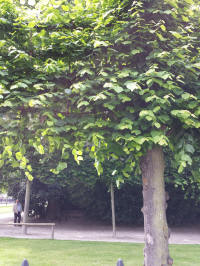 |
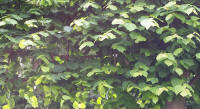
Close-up of trellised trees
seen on left |
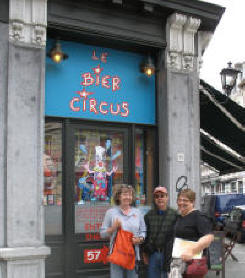 |
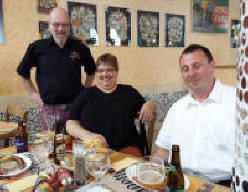
Jean-François picked
Le Bier Circus as our restaurant - it was AWESOME! Beer caps
embedded in plaster coated walls through the entire place!
And they had beer of every kind in Belgium! |
 _________________top__________________
_________________top__________________

The
Atomium & Mini-Europe
Belgium hosted the 1958 World Fair (now called "Expos" and held every two years
in cities around the world). Like the later 1962 Seattle World Fair's
Space Needle, Belgium's main attraction was the Atomium. Nine reflective
spheres are covered in stainless steel connected together to form an iron
crystal ... built with a magnification of 165 billion times. It is 335
feet tall and the each globe measures 59 feet in diameter. External stairs
connect the spaces/globes.
To learn about the first World Fair
click here -
be sure to look at the Exhibits links - the technology was unbelievable
for the day and time!
 |
 |
Dinant
Citadel Scale Model (1/25)
Having visited the site, we were so impressed with the scale
model! They even had a B.A.S.E. jumper dangling off the front edge.
Wondered if there was a good story there!?
|
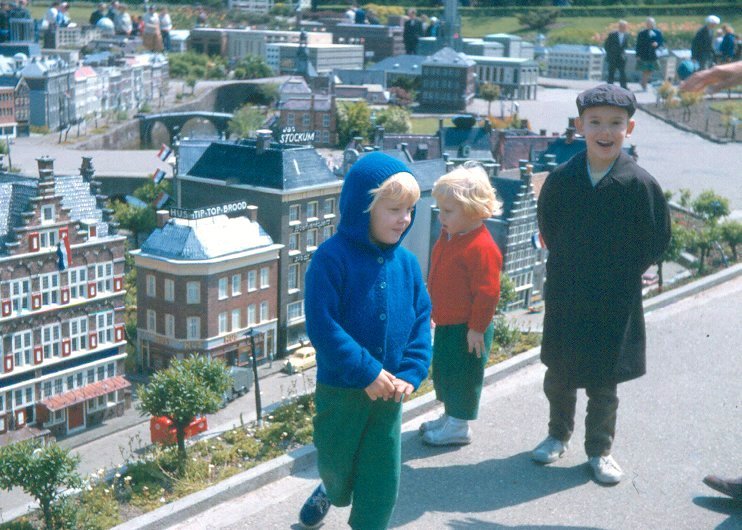 |
When Amy was a wee-one, the family was
returning to the U.S. from living in the Philippines. On the way
back, they visited
Madurodam.
Bob and Amy were not able to get back to the Madurodam.
It is located in the Hague area, NW of Amsterdam.
Where the Atomium highlights all Europe, the
Madurodam showcased just the Dutch venues. It opened in 1952
|
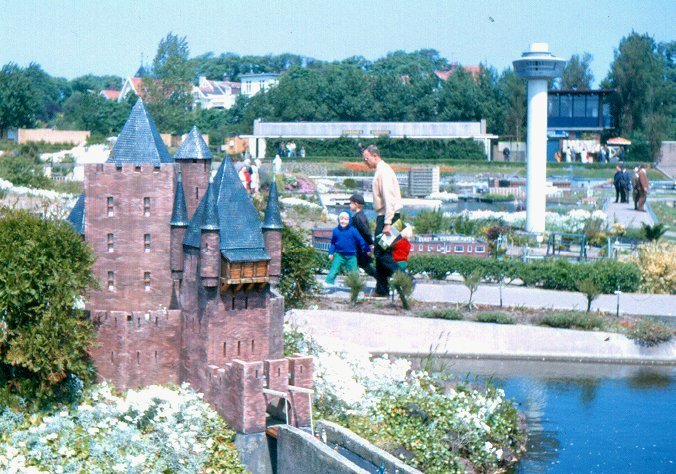 |
 _________________top__________________
_________________top__________________

The End Of Our Day With Jean
Jean was delightful and took on a tour of Brussels that
seconded our best number of steps (14, 421)! Tired did not even express
our feelings. She pointed out some fun (and iconic) areas, including the Sucx candy store, the big white Smurf (Smurfs were invented in Brussels),
and the huge flower pot planters that lined a pedestrian street.
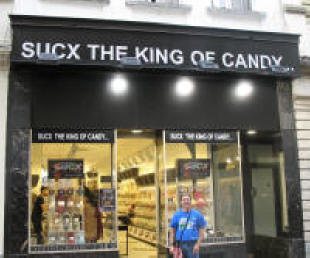 |
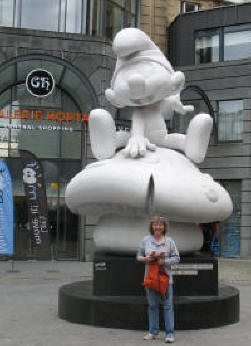
|
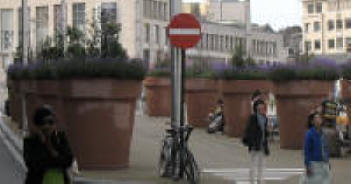 |
| With hugs
and tears we said our goodbyes - she is one extraordinary lady and
married to an exemplary man for the last almost 20 years! We will
miss them and thank them deeply for the great memories! |
 _________________top__________________
_________________top__________________

Last Evening In Brussels
We had said goodbye to Jean and intended to go to bed
early so that we were rested for our flight home. And then ...
Period bands, costumed people, horses, and a big ol'
parade started down the other side of our square. Just had to watch!
| |
|
|
 |
As dusk turned to night (i.e. around 10:00 pm, we
retired to our room at the back of the hotel, only to watch and hear
all the horse mounted re-enactors line up, go off, and come back to
change wardrobes and set off once again. |
 _________________top__________________
_________________top__________________

Home
Our flight home was uneventful. We arrived in the early
evening, hugged our dogs, and canceled our flight plan with mom.
It was a wonderful time!
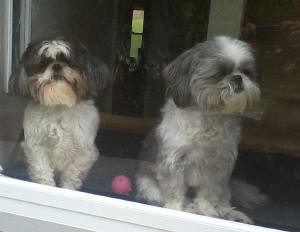
 _________________top__________________
_________________top__________________

Back to Kini
& Kimi's Home Page
Back to Bob
& Amy's Home Page
Email us at bobamy@bobamy.com
|


